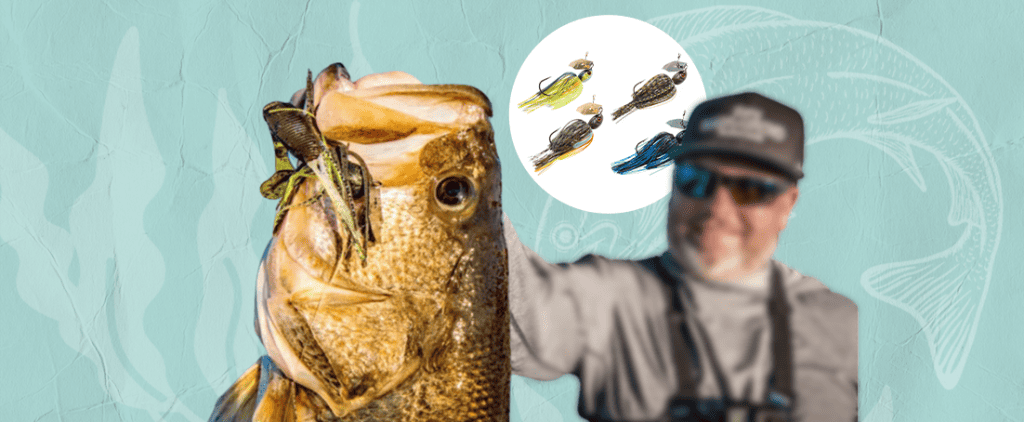
Although efficient, fishing with chatterbait demands a lot of skill to maximize success. So what is a chatterbait, and what are chatterbait fishing tips? Our fishing experts dug and compiled this comprehensive guide on how bass anglers can use this beaver-style bait to get big bass.
For catching the bass, chatterbait fishing is a common and efficient method. A form of bladed jig is called a chatterbait that creates a loud vibrating sound of a wounded fish. It is also known as a bladed jig or vibrating jig and ranks among the most versatile baits for big fish such as bass.
A chatterbait consists of a hex-shaped blade attached to the eye of a jighead. The blade is mostly made of metal, and the jig head often has a skirt on it. It also has a wireline tie attached to the center of the blade. An innovative and versatile lure is made through the combination of a spinnerbait with the vibration of a sharpened jig top.
As a chatter bait fights its way forward, the blade gives way to one side to shed the resistance of the water. It maxes out in that direction and is forced to go in the opposite direction. This blade rocking creates a vibration that runs up the line, down the rod, and through the spine of the angler.
This aggressive action is very effective at triggering a strike from a bass. A bass uses its lateral line to hunt through sense vibration. The disturbance of a vibrating jig is hence easy for them to target and an effective bass lure. But if you include the irregular movement and the blade’s flash, the presentation becomes visually appealing and simulates wounded and fleeing prey.
Manufacturers of the initial ChatterBaits is Z-Man Fishing. The enticement worked. The lures got their name when inventor Ron Davis and his son Ron tested prototypes in 2003. Since Davis’ lure became so well-known, they were unable to fulfill interest and had to sell Z-Man the production rights.
The popularity of the bladed jig continues to grow, and you can find many variations of the bear-style bait offered by other manufacturers. Now that you know how the lure is built and works in the water, here are some tips on how to fish a chatterbait.

Daddy by day, fisherman at night.
Table of Contents
Choose a Technique
To get the most out of your chatterbait, it’s important to understand the different techniques for retrieving it. By understanding the different techniques for fishing with a bladed jig, you can increase your chances of catching big bass. Chatterbaits are versatile lures and can be fished in various ways and with the best rods for chatterbait.
You want to cast your chatterbait out in shallow to mid-depth areas with plenty of structure for the bass to hide. When fishing with chatterbaits, most anglers employ a variety of strategies, always include these four:
Slow rolling
Fast or Burning
Ripping
Pause n’ Go
Slow roll focuses on keeping the chatterbait in the water so the bass can react. It is ideal for deep-water fishing since you want to avoid bringing the chatterbait close to the surface.
The opposing method is fast rolling. Keep the chatterbait near the surface and reel in swiftly. This will make the blade move rapidly, imitating fleeing fish. This technique attracts aggressive bites. Fast retrieve is ideal for catching bass.
Ripping is ideal when slow and fast roll techniques aren’t working. It’s most suitable for non-predatory fish as it produces a swift movement. A chatterbait must be fished very slowly over the top of shallow water before it’s released with a flick of the wrist.
Shaking, often known as “pause and go,” mimics an injured baitfish. You can achieve this by shaking the rod tip up, down, and all around as you retrieve. The jig head darts making the skirt pulse and flare.
When retrieving a chatterbait, it is best to use a braided line and a medium-action rod with a 6.4 to 7.3 gear ratio. This will enable you to keep the bait under control and change the speed of the retrieve.
When fishing with a chatterbait, it is important to vary the retrieve speed and depth to maximize the effectiveness of the bait. This is true for a majority of moving baits, but bladed jigs are especially applicable. Because many anglers use sticks, the fish have become accustomed to seeing a simple straight retrieve.
When fishermen vary the retrieve and add a few hard cranks, it gives the fish a different look and imitates wounded, frantic prey. A slower retrieval works best in cold water, while a faster retrieval is more effective in warm water. The bait ought to be retrieved straight while fishing in low waters; in deeper water, the bait should be retrieved with a jigging action.
The ideal retrieve depth for landing fish for a chatterbait depends on the weight of the lure and the depth of the water. Generally, a bladed jig works best in areas less than 10 feet deep with vegetation.
Additionally, picking the appropriate chatterbait trailer is crucial. A swimbait-style trailer performs better in deeper water, whereas a crawfish-style trailer excels in shallow water. Finally, it is important to choose the right size for the trailer. For example, in the winter, a 3 or 4-inch trailer is best, while in the summer, a 5 or 6-inch trailer works best.
Many anglers prefer blending the color of the ChatterBait with the trailer, though there are modifications to enhance their productivity. The bass may grab the tail and miss the hook if it’s too long. Many anglers employ a trailer hook that attaches to the ChatterBait hook to avoid short strikes. Another option is to cut the front end of the trailer to shorten it.
Select The Right Chatterbait
The color of the fish chatter baits is another crucial factor. Some colors work better based on the season or your surroundings. The following colors perform well across the country:
-
Blue/black: Blue and black are the most typical colors of chatter baits used for bass fishing. For low light, poor water visibility, and high spring weed conditions, go for the skirt with a dark trailer that is black and blue.
-
Blue: During spawning, largemouth bass eats bluegills, therefore, a chatter bait decorated with their patterns is an effective weapon. Use this chatter bait in areas where you know there are Bluegill beds.
-
Red: Red chatter lures are effective for catching bass in cool waters and early spring. The red color is excellent for slow rolling in the grass or ripping the chatter bait.
-
Pearl: Pearl swimbait with a shad chatterbait flickers on the surface, attracting bass in the spawn and early summer seasons.
-
Green pumpkin: This is the best chatterbait color for all year-round scenarios. It looks natural in darker water, stained water, open water, and clearer water. For best results, match it with a lighter or dark green trailer.
While choosing the right color, choose a shade similar to the bait fish you’re trying to imitate. The most appealing hues are pearl white and green pumpkin country areasbecause they resemble shads and sunfish. Vibrant color is ideal for murky water, while natural colors work great in clear water situations.
Weather Conditions
How to use chatterbait fishing for bass also depends on the season.
Fishing a chatterbait is challenging during winter due to the fact that fish tend to travel farther into the ocean and the low water temperature.
But the good news is that you can still get fish a chattterbait even with this temperature—the key when fishing during winter is finding the right baitfish. If you find them, you can also find fish.
Once the water starts to warm, fishes start to surface, and this is now the best opportunity for you to use chatterbait. Using chatterbait during spring tends to gravitate towards the water and attracts fish.
In the summer, when the vegetation is at its thickest, it can completely engulf bays, lagoons, and shallow areas of any lake. During this time, cast your chatterbait along the weed lines. It’s even better if the weed line is close to a drop-off.
When fishing during summer, the best time to fish is at night as it gives you the intensity and allows you to cover the water and get as much fish as possible. When you cast the lure during this season, it is just a matter of time before you can catch the big fish.
When fishing during the fall season, you notice that it gets challenging to fish since the temperature starts to change. Bass go to shallow water in the fall, and vegetation starts to dwindle. You can go to shallower spots and find gaps in the vegetation to fish from.
Since it can be quite tough to fish during the fall season, you may want to use different ways to catch fish. Some professional anglers use this lure as a jerkbait, and you will be surprised that it can give you nice results. Before casting the bait, make sure it is rigged up.
Patience
In any situation involving poor water visibility, it is usually preferable to employ a slow retrieval speed when employing chatterbaits.
You want to give the bass enough time to swim close and look at your lure. Occasionally, the bass may follow your lure to the boat without biting, and in those cases, a great tactic is to give your lure a jerk now and then, which can trigger the fish to commit and grab the bait.
